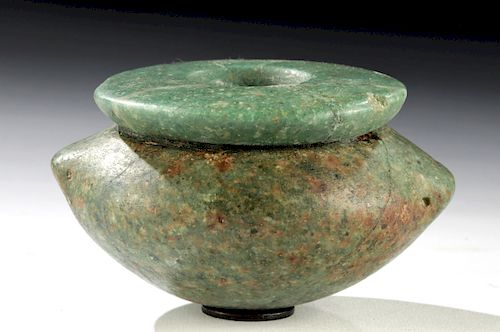Gorgeous Egyptian Predynastic Naqada Greenstone Jar
Lot 5
About Seller
Artemis Fine Arts
686 S Taylor Ave, Ste 106
Louisville, CO 80027
United States
Selling antiquities, ancient and ethnographic art online since 1993, Artemis Gallery specializes in Classical Antiquities (Egyptian, Greek, Roman, Near Eastern), Asian, Pre-Columbian, African / Tribal / Oceanographic art. Our extensive inventory includes pottery, stone, metal, wood, glass and textil...Read more
Categories
Estimate:
$4,000 - $6,000
Absentee vs Live bid
Two ways to bid:
- Leave a max absentee bid and the platform will bid on your behalf up to your maximum bid during the live auction.
- Bid live during the auction and your bids will be submitted real-time to the auctioneer.
Bid Increments
| Price | Bid Increment |
|---|---|
| $0 | $25 |
| $300 | $50 |
| $1,000 | $100 |
| $2,000 | $250 |
| $5,000 | $500 |
| $10,000 | $1,000 |
| $20,000 | $2,500 |
| $50,000 | $5,000 |
| $100,000 | $10,000 |
| $200,000 | $20,000 |
About Auction
By Artemis Fine Arts
Sep 26, 2019
Set Reminder
2019-09-26 10:00:00
2019-09-26 10:00:00
America/New_York
Bidsquare
Bidsquare : Exceptional Day 1: Antiquities & Asian Art
https://www.bidsquare.com/auctions/artemis-gallery/exceptional-day-1-antiquities-asian-art-4437
Day 1 of an important 2-day auction featuring exceptional, museum-worthy examples of Egyptian, Greek, Etruscan, Roman, Viking, Russian, Near Eastern, as well as Asian Art from China, Japan, Thailand, Vietnam, Burma and India. Artemis Fine Arts info@artemisfinearts.com
Day 1 of an important 2-day auction featuring exceptional, museum-worthy examples of Egyptian, Greek, Etruscan, Roman, Viking, Russian, Near Eastern, as well as Asian Art from China, Japan, Thailand, Vietnam, Burma and India. Artemis Fine Arts info@artemisfinearts.com
- Lot Description
Ancient Egypt, Predynastic Period, late Naqada II to Naqada III, ca. 3200 to 3000 BCE. A gorgeous jar hand-carved from attractive mottled emerald-green stone with dark-grey, white, and citrine inclusions. The jar is defined by a round but stable base, a carinated midsection with a pair of unperforated lug handles, a squat neck, and a thick discoid rim surrounding a petite mouth. Stone jars were typically used for containing thick cosmetic make-up used by both men and women known as kohl. However, based on their use during pre-burial rituals, scholars posit that jars like this example perhaps contained precious scented oils or even volatile substances. An attractive and well-preserved example from the earliest periods of ancient Egypt! Size: 3.6" W x 2.1" H (9.1 cm x 5.3 cm).
In addition to being quite striking, this jar represents a technological leap forward for the ancient Egyptians. In the early Pre-Dynastic period, artisans hollowed out hard stone vessels using hand-held stone borers and abrasive desert sand. Then, during the Naqada II period (ca. 3600 to 3200 BCE), the invention of copper tubes used to drill very hard stones (in conjunction with sand as an abrasive), allowed people to drill finer forms - like, for example, these lug handles. However, copper drills only allowed artisans to drill cylindrical items, and so the hollowing out of bulbous vessels like this one still required use of an elongated stone borer in the form of a figure-eight to get under the shoulder. Imagine the hours of work that went into making this single jar!
Provenance: private East Coast, USA collection; ex-private Paris, France collection, acquired in the 1970s
All items legal to buy/sell under U.S. Statute covering cultural patrimony Code 2600, CHAPTER 14, and are guaranteed to be as described or your money back.
A Certificate of Authenticity will accompany all winning bids.
We ship worldwide and handle all shipping in-house for your convenience.
#147924Repaired from multiple large pieces, with light amounts of fill material in some chipped areas, and resurfacing over break lines. Light abrasions to base, lug handles, and rim, with one petite chip to rim, and minor encrustations within body. Light earthen deposits throughout.Condition
- Shipping Info
-
All shipping is handled in-house for your convenience. Your invoice from Artemis Gallery will include shipping calculation instructions. If in doubt, please inquire BEFORE bidding for estimated shipping costs for individual items.
-
- Buyer's Premium



 EUR
EUR CAD
CAD AUD
AUD GBP
GBP MXN
MXN HKD
HKD CNY
CNY MYR
MYR SEK
SEK SGD
SGD CHF
CHF THB
THB
















